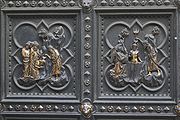
Andrea Pisano
Encyclopedia

Italian people
The Italian people are an ethnic group that share a common Italian culture, ancestry and speak the Italian language as a mother tongue. Within Italy, Italians are defined by citizenship, regardless of ancestry or country of residence , and are distinguished from people...
sculptor
Sculpture
Sculpture is three-dimensional artwork created by shaping or combining hard materials—typically stone such as marble—or metal, glass, or wood. Softer materials can also be used, such as clay, textiles, plastics, polymers and softer metals...
and architect
Architect
An architect is a person trained in the planning, design and oversight of the construction of buildings. To practice architecture means to offer or render services in connection with the design and construction of a building, or group of buildings and the space within the site surrounding the...
.
Biography
Andrea Pisano was born at PontederaPontedera
Pontedera is an Italian industrial town in Tuscany, Italy, in the administrative province of Pisa. It is the headquarters of the Piaggio company, which in the 1930s was a major aircraft manufacturer and which now manufactures motor vehicles such as the Vespa and the Ape...
, where he also died.
He first learned the trade of a goldsmith. Pisano then became a pupil of Mino di Giovanni, about 1300, and worked with him on the sculpture for S. Maria della Spina at Pisa
Pisa
Pisa is a city in Tuscany, Central Italy, on the right bank of the mouth of the River Arno on the Tyrrhenian Sea. It is the capital city of the Province of Pisa...
and elsewhere. He made his chief works in Florence, and the formation of his mature style was due rather to Giotto di Bondone
Giotto di Bondone
Giotto di Bondone , better known simply as Giotto, was an Italian painter and architect from Florence in the late Middle Ages...
than to his earlier master. Of the three world-famed bronze doors of the Baptistery in Florence
Battistero di San Giovanni (Florence)
The Florence Baptistry or Battistero di San Giovanni is a religious building in Florence , Italy, which has the status of a minor basilica....
, the earliest one that on the south side was Pisano's work; he started it in 1330, finishing in 1336. It consists of a number of small quatrefoil panels the lower eight containing single figures of the Virtues, and the rest scenes from the life of John the Baptist
John the Baptist
John the Baptist was an itinerant preacher and a major religious figure mentioned in the Canonical gospels. He is described in the Gospel of Luke as a relative of Jesus, who led a movement of baptism at the Jordan River...
.
Andrea Pisano, while living in Florence, also produced many important works of marble sculpture, all of which show strongly Giotto's influence. In 1340 he succeeded Giotto as Master of the Works of Florence Cathedral. There he produced a series of reliefs, possibly designed by his former teacher as, for instance, the double band of panel-reliefs which Pisano executed for the great campanile. The subjects of these are the Four Great Prophets, the Seven Virtues, the Seven Sacraments, the Seven Works of Mercy and the Seven Planets. The duomo contains the chief of Pisano's other Florentine works in marble. In 1347 he became Master of the Works at Orvieto Cathedral, which had already been designed and begun by Lorenzo Maitani
Lorenzo Maitani
Lorenzo Maitani was the Italian architect and sculptor primarily responsible for the construction and decoration of the façade of Orvieto Cathedral....
. These and the aforementioned doors are Pisano's only known works. Pisano also contributed to freeing modern art
Modern art
Modern art includes artistic works produced during the period extending roughly from the 1860s to the 1970s, and denotes the style and philosophy of the art produced during that era. The term is usually associated with art in which the traditions of the past have been thrown aside in a spirit of...
from Byzantine
Byzantine art
Byzantine art is the term commonly used to describe the artistic products of the Byzantine Empire from about the 5th century until the Fall of Constantinople in 1453....
influence. He died in 1348.
Andrea Pisano had two sons, Nino
Nino Pisano
thumb|280px|"Euclid", panel from [[Giotto's Bell Tower]], now in the [[Museo dell'Opera del Duomo |Museo dell'Opera del Duomo]], [[Florence]].Nino Pisano thumb|280px|"Euclid", panel from [[Giotto's Bell Tower]], now in the [[Museo dell'Opera del Duomo (Florence)|Museo dell'Opera del Duomo]],...
and Tommaso. Both, especially the former, succeeded him as Master of the Works at Orvieto Cathedral.
Giorgio Vasari
Giorgio Vasari
Giorgio Vasari was an Italian painter, writer, historian, and architect, who is famous today for his biographies of Italian artists, considered the ideological foundation of art-historical writing.-Biography:...
includes a biography of Andrea Pisano in his Lives
Lives of the Most Excellent Painters, Sculptors, and Architects
The Lives of the Most Excellent Italian Painters, Sculptors, and Architects, from Cimabue to Our Times, or Le Vite de' più eccellenti pittori, scultori, e architettori da Cimabue insino a' tempi nostri, as it was originally known in Italian, is a series of artist biographies written by 16th century...
.
Pisano's chief pupil was Andrea di Cione, better known as Andrea Orcagna
Andrea Orcagna
Andrea di Cione di Arcangelo , better known as Orcagna, was an Italian painter, sculptor, and architect active in Florence. A student of Andrea Pisano as well as Giotto di Bondone, his younger brothers Jacopo di Cione and Nardo di Cione were also artists...
. Another pupil, Giovanni di Balduccio
Giovanni di Balduccio
Giovanni di Balduccio was an Italian sculptor of the Medieval period. He was born in Pisa, and likely did not train directly with the famous Pisan sculptor Andrea Pisano. He travelled to Milan to help sculpt the arc of St. Peter Martyr now in the Portinari Chapel, in the Basilica of...
, executed the shrine of Sant'Eustorgio at Milan.

